Small when compared to other U.S. states, South Carolina packs a lot into its borders. The state includes everything from coastlines and subtropical climates to deserts and alpine regions, along with the 450 diverse bird species that call these areas home. Of the many birds that call South Carolina home, four species of owl live year-round within the state. An additional five types of these nocturnal predators have been reported while migrating through, though they may be harder to spot. Owls are most active at night, so in order to see an owl in the wild, you will also have to be out and alert at these times. Grab your flashlight and let’s explore the nine owls that live in South Carolina, even temporarily!
Year-Round Residents
1. Great Horned Owl
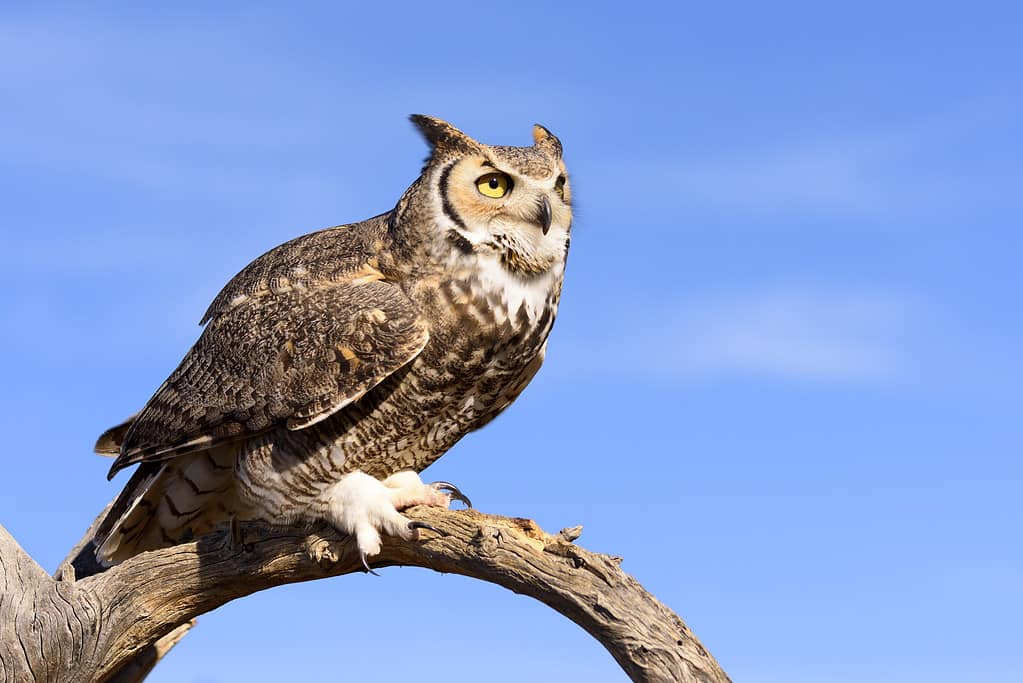
Great horned owls live throughout North America.
©kojihirano/iStock via Getty Images
Bubo virginianus
One of the largest and most recognizable owl species, the great horned owl lives throughout South Carolina as the state’s largest resident breeding owl. This owl is iconic with its tall ear tufts, bright yellow eyes, and dark brown-and-black feathers. Great horned owls eat a wide variety of prey and therefore make their homes in a diverse range of habitats. They live nearly everywhere, including wetlands, deserts, forests, grasslands, and even urban areas. Because of this, great horned owls may be the easiest to spot for bird watchers throughout the state. However, Santee National Wildlife Refuge near Lake Marion may offer the best chances of seeing these majestic hunters.
2. Eastern Screech Owl
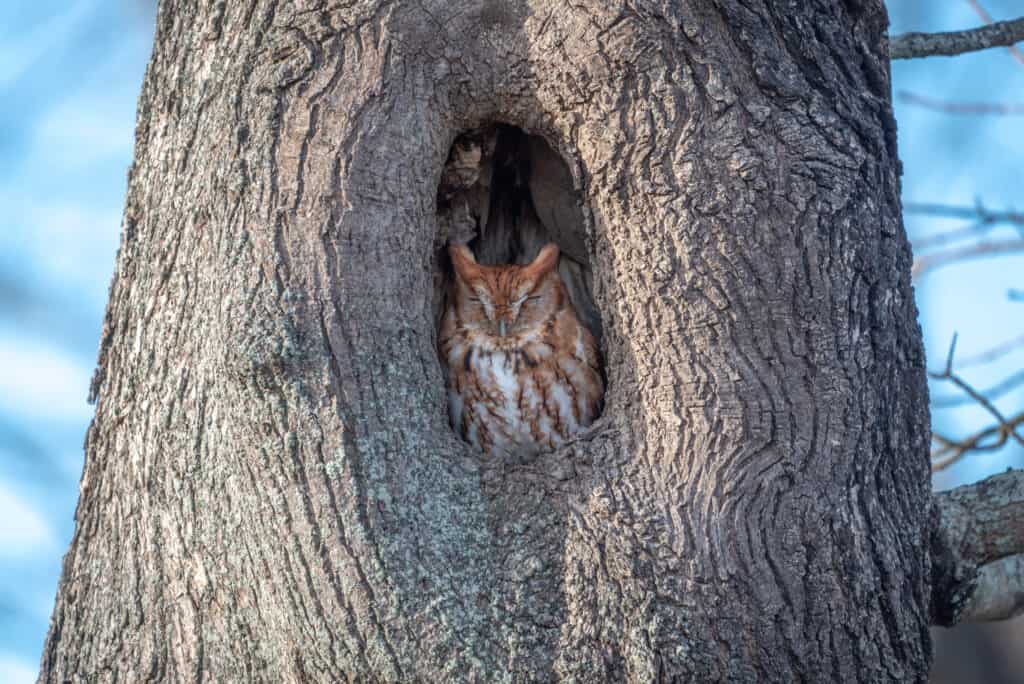
Eastern screech owls sleep wherever they can find a safe place.
©Kathryn Bedard/Shutterstock.com
Megascops asio
We go from South Carolina’s largest breeding owl to its smallest with the eastern screech owl. These owls have tall ear tufts, yellow eyes, and dark banding with two color variants: dark gray and a rusty orange coloration called rufous. Eastern screech owls with rufous coloring also have much more white on their faces and on the underside of their feathers. These owls are opportunists, taking advantage of nearly any available nesting site. They’re known to nest anywhere, including nesting boxes, old mailboxes, or even crates left on the ground! Eastern screech owls have adapted to the presence of humans better than other owls, so they’re a common sight in suburban areas. High sighting reports come from the Savannah National Wildlife Refuge, the Francis Marion National Forest, and the Congaree National Park.
3. Barn Owl
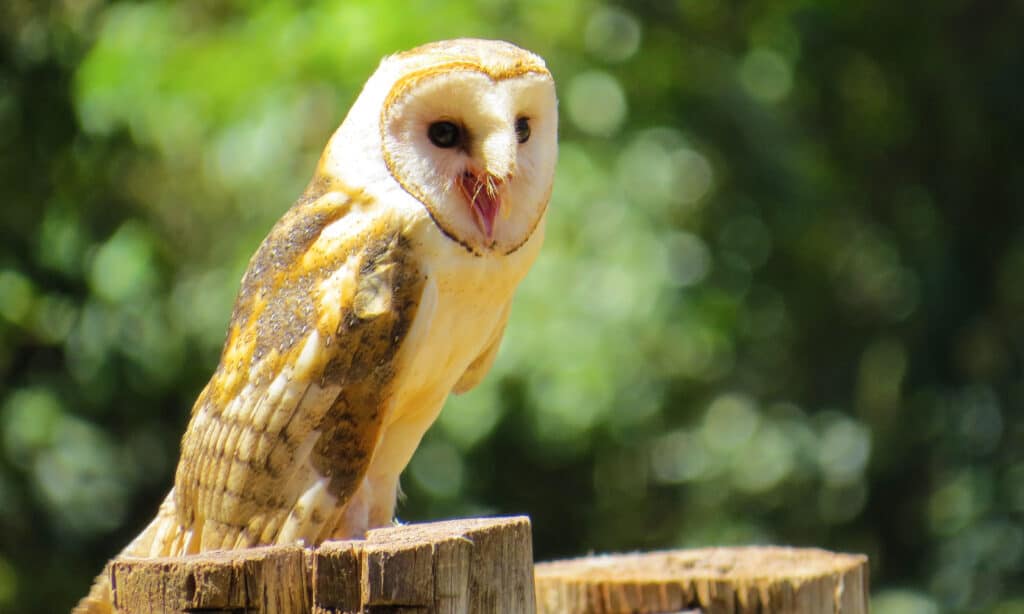
Their pale coloration sets barn owls apart from most other owl species.
©DEBORA DUARTE LISBOA/Shutterstock.com
Tyto alba
Barn owls are another instantly recognizable addition to our list. With their moon-shaped face, dark eyes, pale coloration, and a call that sounds like a raspy scream, these owls earn their nickname of “ghost owl.” Barn owls make their homes in abandoned or seldom-used buildings. They also prefer to hunt in open spaces like agricultural land, making them common sights on farms and in suburban areas. Barn owls can be seen throughout South Carolina, though Congaree National Park, Oak Ridge Greenway, and Francis Marion National Park make great places to go looking for these haunting hunters.
4. Barred Owl

Barred owls are easily recognizable thanks to their feather patterns.
©FotoRequest/Shutterstock.com
Strix varia
The barred owl boasts a visually striking set of feathers. Their unique coloration results in vertical streaks on their bellies, with horizontal stripes on their chests and heads. With dark eyes and a yellow beak, these owls are beautiful! They may also be the most commonly seen owl in South Carolina because they’re most active during dusk and dawn, when people are still out and about. Barred owls prefer to nest in old forests, especially near water sources like streams or swamps. With such a particular nesting habit, the best places to see barred owls may be Sumter National Forest, Clemson Experimental Forest, and Francis Marion National Forest.
Seasonal Visitors
5. Long-Eared Owl
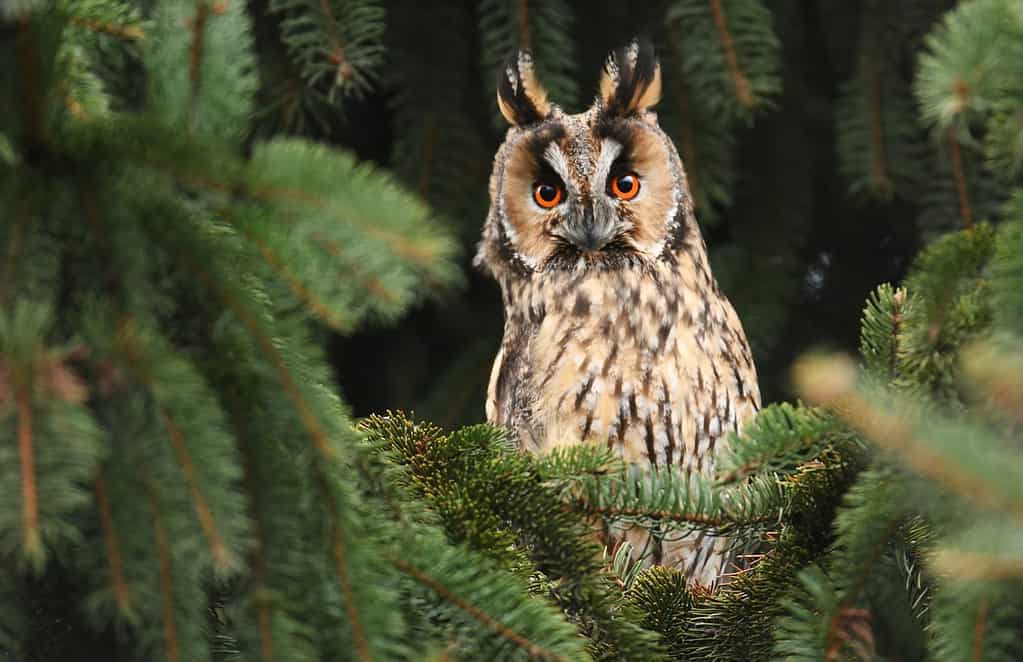
Long-eared owls use their big ear tufts to help track prey.
©Piotr Krzeslak/Shutterstock.com
Asio otus
Often compared to great horned owls, long-eared owls share the same large ear tufts, bright yellow eyes, and orange-ish faces. However, long-eared owls are smaller and have much more white in their coloration, in addition to lighter browns and grays. Long-eared owls visit South Carolina in the winter and are most common in the northern parts of the state among grasslands, shrublands, and open woodlands. Bird enthusiasts most commonly identify them by their low “whoo” hoots. However, these owls rarely call outside of breeding season, so they can be tough to spot. Sightings have been reported on Clemson University’s campus, as well as at Congaree National Park.
6. Short-Eared Owl
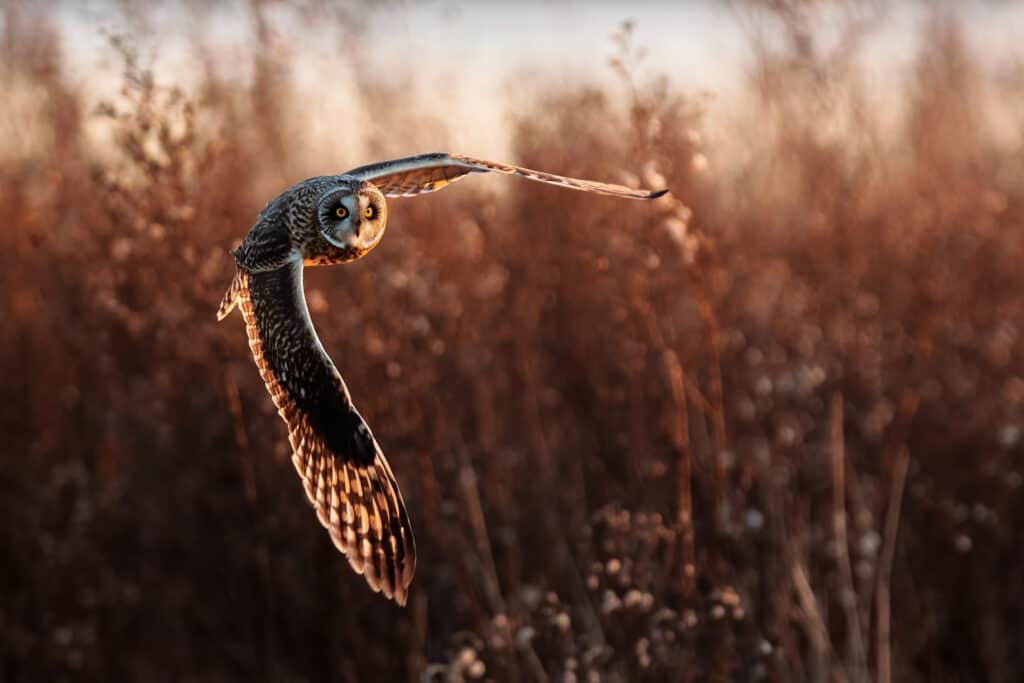
Unlike other owls, short-eared owls hunt during the day.
©RobDemPhoto/Shutterstock.com
Asio flammeus
The short-eared owl was named for its short ear tufts it extends while hunting. Dark feathers frame their bright yellow eyes while the rest of its feathers range between white and dark brown for a streaked appearance. Short-eared owls break the nocturnal mold and prefer to hunt during the day. Their diverse diet makes them flexible in their hunting grounds, ranging from coastal grasslands to tundras and everything in between. Short-eared owls visit South Carolina in the winter and can be spotted in a variety of places, including J. Strom Thurmond Lake, Clemson Experimental Forest, and the Savannah National Wildlife Refuge.
7. Burrowing Owl
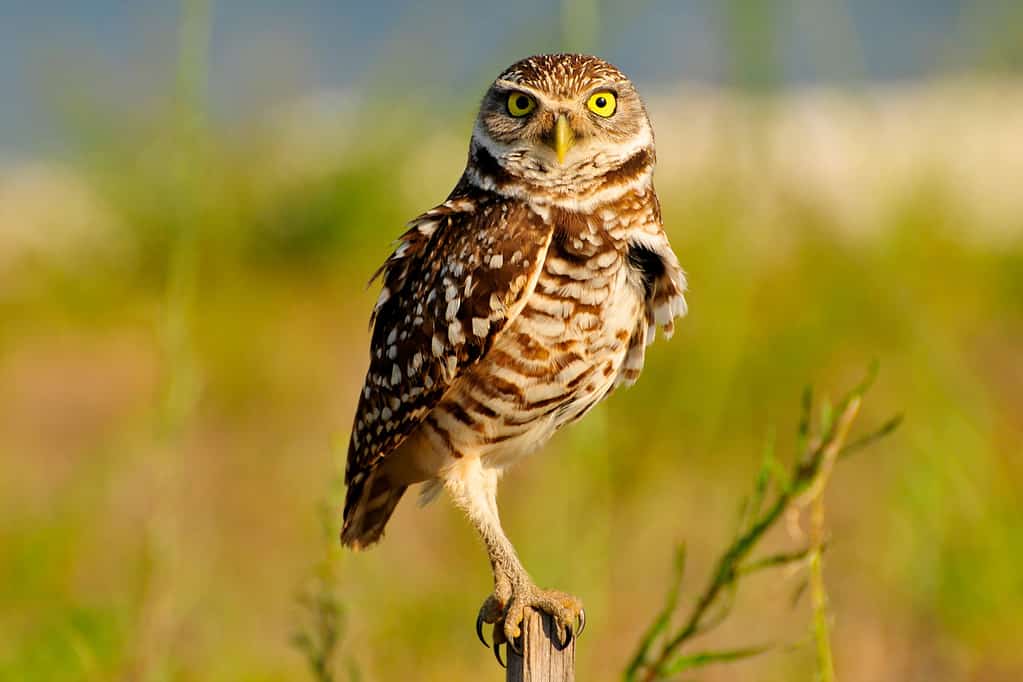
Burrowing owls prefer grasslands to forests as they hunt their small prey of mammals and insects.
©Joliegordon/iStock via Getty Images
Athene cunicularia
These long-legged, small owls primarily live farther west, but occasionally make their way to South Carolina while migrating. Burrowing owls make their homes in the ground and prefer open areas with sparse vegetation, like agricultural fields, deserts, or grasslands. Their feathers span shades of brown, helping them blend in with their habitat. For the best chance to see one of these rare visitors to the state, visit the ACE Basin National Wildlife Refuge or the Francis Marion Forest Reserve.
8. Northern Saw-Whet Owl
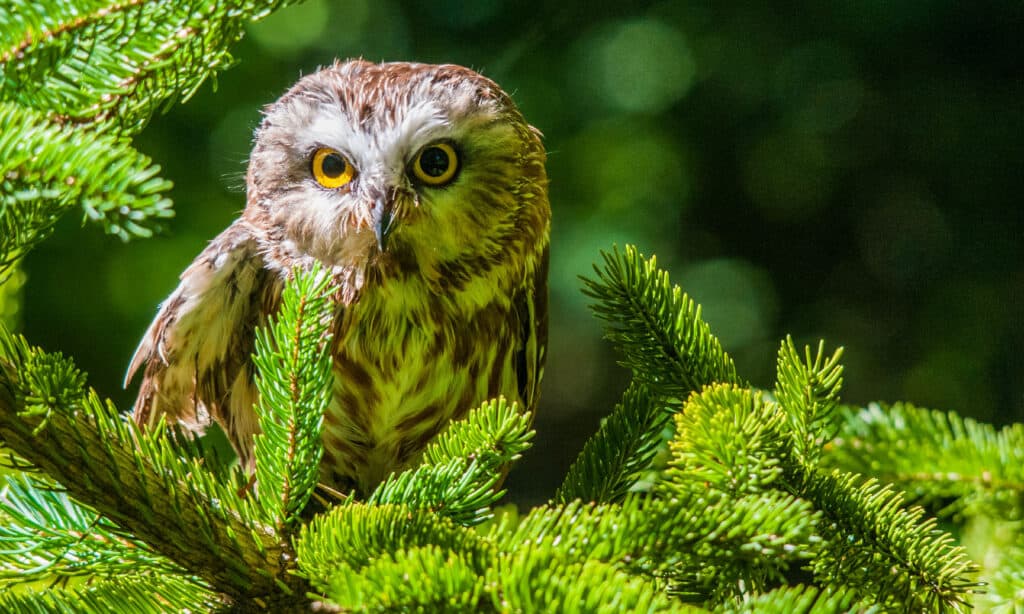
These tiny owls have deceptively loud hoots, making their “too-too-too” calls echo during mating season.
©iStock.com/bookguy
Aegolius acadicus
The northern saw-whet owl is one of the smallest owl species in North America. They occasionally make their way to South Carolina to enjoy the state’s milder winters. Their faces feature white feathers with brown mottling, while their backs are primarily brown. Northern saw-whet owls prefer to live and hunt in dense forests, especially near water sources. The best spots to see one of these tiny visitors is the Clemson Experimental Forest and the Francis Marion National Forest.
9. Snowy Owl
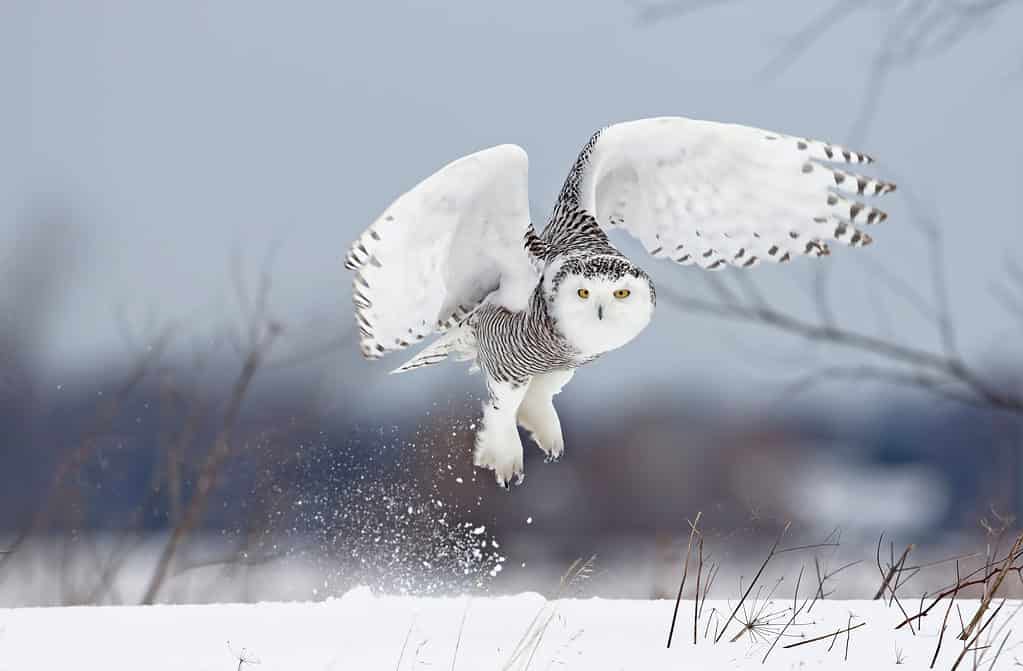
The snowy owl travels much more than other owls, tracking its sparse prey in the cold north.
©Jim Cumming/Shutterstock.com
Bubo scandiacus
With its lovely white feathers and piercing yellow eyes, the snowy owl perfectly blends in with its main habitat in the far north. These arctic beauties are very rare to see so far south, but have been reported among South Carolina’s open fields and dunes. Snowy owls migrate much like other birds, aiming to escape the harshest of the northern weather by traveling south. They primarily hit South Carolina in the middle of winter, between December and January. If you’re lucky enough to spot a snowy owl, it will most likely be at Congaree National Park, Francis Marion National Forest, or ACE Basin National Wildlife Refuge.
The photo featured at the top of this post is © iStock.com/Bobliving
Thank you for reading! Have some feedback for us? Contact the AZ Animals editorial team.






